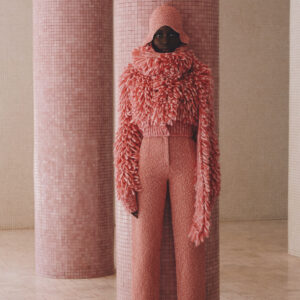Colville / In Conversation
Interview 09.06.20
Interview Simone Konu Rae and Katy Lassen Photography Clare Shilland Styling Lucinda Chambers
Having worked together for over a decade, it felt natural for Lucinda Chambers and Molly Molloy to team up for a new venture when they left their previous roles. Moving on from over 20 years as Fashion Director of British Vogue and Head of Womenswear at Marni respectively, the pair launched Colville in 2018. Fusing creative collaboration, sustainability and flexibility for the modern woman, Colville’s offering is bold, eclectic and unique.
Featuring the Spring Summer 20 collection in an exclusive series for ALSO, photographed by Clare Shilland and styled by Lucinda. ALSO co-founders Simone Konu Rae and Katy Lassen sat down with Lucinda and Molly over video call during the lockdown to talk about their creative process, up-cycling, the power of collaboration and the global network of women behind this colourful, optimistic label.

Simone: We love the shoot that you have shared with Also for SS20, thank you! How important is it to you both to use imagery to communicate the story of the Colville woman?
Lucinda: We always have done, we don’t do shows so the communication aspect in Colville is really massive. I think what feels very different about Colville is that it’s about a collection and it’s about different people. And it’s about a community of people that we really shout out about a lot. Molly is a big people collector, and the collaboration element has been there right from the beginning. This has stood us in really good stead because we can reach out to a lot of different people.
We have a lot of people on board who are like our extended family in a way. But it was always about collaboration. At the beginning it was about the three of us (co-founder Kristin Forss recently stepped back from the brand) and then our assistant Danny joined, Valeria making the jewellery and Marcus making bags, and so on. Molly meets people and I meet people and we just keep on adding on to this sort of wonderful collective. So storytelling and being social is second nature to us.
Katy: I always think that a brand that’s got a stylist involved, is at an advantage right from the offset. Because you avoid the bit where some brands wonder how they will communicate the clothing to the customer. I wonder are you already seeing ahead when you’re designing the clothes, about how you might want that imagery to communicate the collections?
Molly: When we’re designing, we’re always thinking, oh, we’re going to put that with this and thinking of how we are going to put things together. We are always looking for and finding new collaborators, photographers, etc, keeping a note of them for future projects. Our process is quite organic.
L: Molly is just as interested in the styling as I am really, and it goes hand in hand with the design. We are constantly both adding all the bits together. Just the other day Molly got this great new artist on board and then I was texting her about zips, we are really embedded in everything together.
M: In terms of imagery I was thinking about it the other day, how everything is changing, the shift in the fashion calendars and the pressure on designers to produce images. It used to be that a brand would just do a collection and then just do a show and then maybe you would do a lookbook but that would be about it. There wasn’t ever that pressure to produce a constant stream of imagery. I mean, I love it and it feels really natural for us, so it doesn’t feel like we are under pressure to do it. These days you do have to have what they call assets but it comes quite naturally to us and we’re always thinking about it; there might be a model in the studio and we love her and she loves the clothes and it feels right so we’ll take a picture and I’ll use it on Instagram.
L: A big part of Colville as well, is the fact that we love people to take it away and take it somewhere else. We’re really not control freaks. And I think what’s really interesting is, I don’t think we’re at all precious about who it goes to and what they do with it. You know, if somebody says ‘I’ll take away your blankets and I’ll just do a project” and if we believe in them then that trust is just fantastic. It’s really nice to see other people’s interpretation of things. And we really enjoy that we don’t worry about how things have to be worn or that they should be shown a certain way. We all really enjoy that moment when we see other people’s interpretation of Colville. It’s just fantastic.
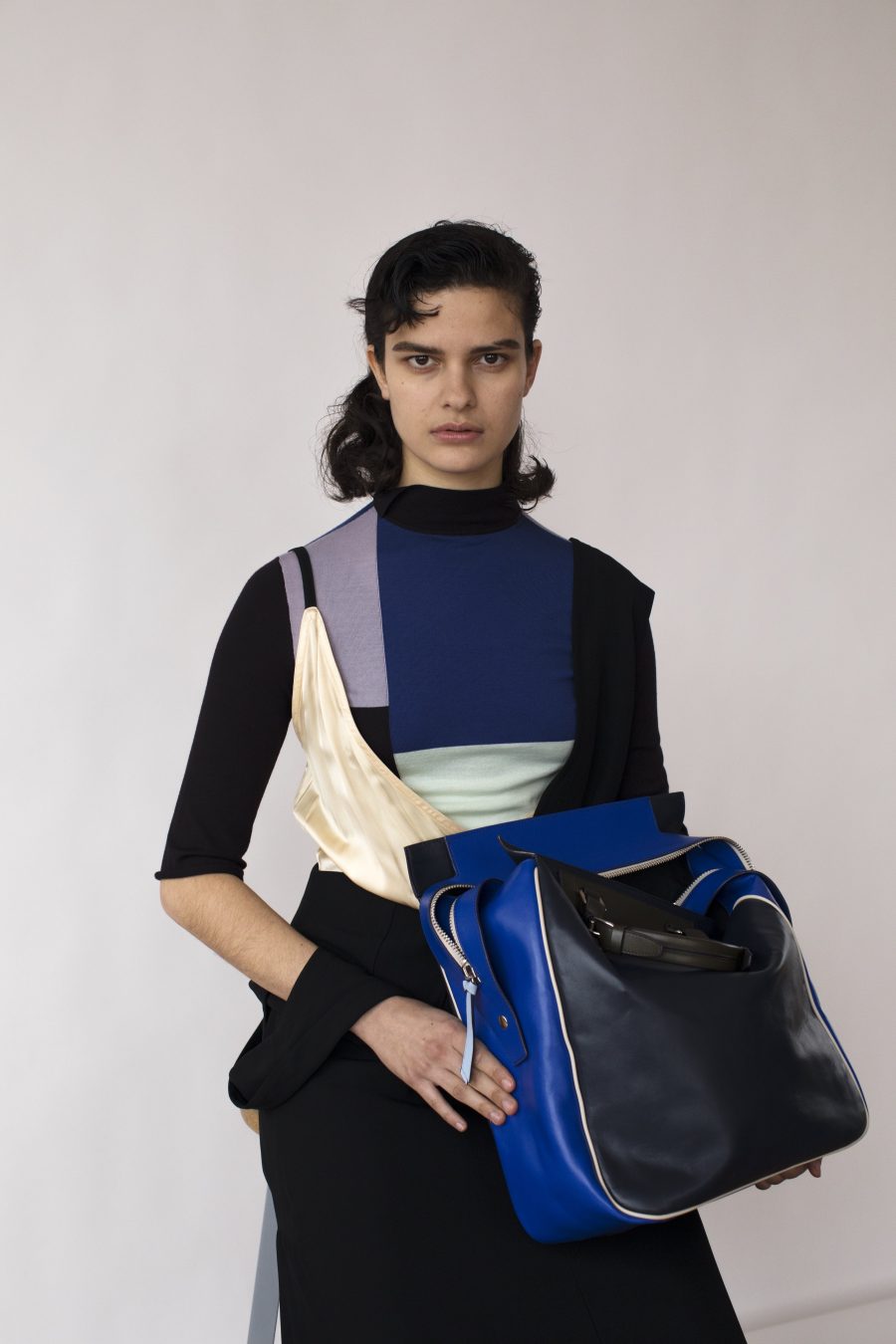
K: That’s really refreshing to hear as there are so many brands who seem to have become so incredibly obsessed about the control element, the full look policy for instance. As a Fashion Director Lucinda you must understand that frustration.
L: It has gotten worse and worse and worse. Brands will give a stylist a front row seat, will show us how in an ideal scenario one would wear it. And that’s terrific and wonderful and fabulous. But then with a full look policy they are saying ‘but I don’t want to see how you’re going to do it’. I just want the good review. It feels really odd to me. It feels so unconfident. Why are you not curious about chucking it out there and seeing what people are going to do with it? I find that really, really odd.
S: Thinking about the idea of assembling collections and coming from a stylist’s point of view, the Colville collection seems to have embedded that level of flexibility that you’re promoting to the wearer as well. You have previously discussed the idea that things can be reassembled and put together in your own way, how important do you think that notion of flexibility is for the contemporary woman within their wardrobes?
M: Yes absolutely, I love seeing Colville mixed up with other pieces. Lucinda and I mix it up too. I love the fact that it’s not strict in any way, it’s very free. We decided to start Colville because we wanted to create a wardrobe for ourselves. After Marni and Celine (changed design directors) we didn’t know where to go. Where do we shop now? What speaks to us? So that’s one of the reasons we started Colville, to see if we could start building our own house.
I think at the beginning, I thought our audience would probably just be like-minded people, maybe our age, maybe a little bit younger, but actually, it’s been really surprising. We have such a broad demographic, and it has done really, really well. We’ve only been wholesaling for three seasons but it’s really interesting and quite surprising because I’ve never thought a 25-30 year old would be our kind of customer, and it was never our target. But in fact a lot of young people responded to it. But then also mine and Lucinda’s friends too.
L: You can make it your own, it doesn’t wear you, you wear it. And I think you can be quite a lot of different people wearing Colville. You can look quite quite boyish in it, in the tees and sweaters and coats. But you can also look very feminine, especially the pink ruffle dresses. It sounds like it’s all over the place, but it’s not, it’s actually quite concise. Evangeline (the model) was really good for this shoot because she just made it look as if she would wear it that way. She made it look as if she was inhabiting the clothes.
I think there are a lot of entry points into Colville. You can be quite masculine with it or you can be quite feminine or you can be both, you know, which I think Molly and I both are. Were both quite feminine and masculine at the same time.

K: This leads us nicely into asking you a bit more about the Colville woman and who she is, not just in the way she dresses but in her attitude?
L: It’s funny you ask that as there was a brilliant picture last week of Helena Bonham Carter wearing one of our skirts but looking really grumpy and angry. Apparently she’s worn it for the whole of lockdown. It’s Molly’s mad flower design and she wore it with chunky sandals and a t-shirt. Our woman makes bold choices in what she wears. It’s certainly not the husbands buying it for women that’s for sure!
M: Everything has details, even if it’s simple. We want to make women feel special and confident and yes they are bold but then also at the same time I think they have a softness too.
L: I don’t think the clothes are sharp and difficult. They’re made to be worn and washed and worn with lots of different things. I think the Colville woman is a Tilda (Swinton), she is a Helena (Bonham Carter); women with attitude but also with an inner life as well.

S: How has this extended quarantine slash lockdown period influenced the way that you’re wearing Colville and how this might influence the brand for the future? You mentioned Helena Bonham Carter wearing that skirt all the time, has there been anything that has resonated with you in that way?
L: I have always thought my Colville pieces are really precious and I really want to take care of them because I really love them. But actually, when I am working I’m always cold and the other day I put on my Colville sweater. I suppose we wait for special occasions and then I was like well for God’s sake get over that, it’s such a great sweater to wear every day! I was keeping things for best but I’m not going to do that anymore, I am going to get the wear out of them.
M: So we are two weeks ahead of you (in lockdown) and for the first few weeks I was only in t-shirts and jeans. But then I had a really low moment and I thought if I just get dressed up and put some lipstick on and an earring, because I just have to do something to make myself feel good and feel like I’m going somewhere even if it’s just to the bedroom. And it works! It works.
I was Zooming with a group of girls who weren’t wearing makeup and they were like, oh you’ve done a black eyeliner! They really noticed and said right we are going to do that too. Why not! So I have started to make a bit more of an effort, a bit like Lucinda and her sweater, starting to think about it in a different way, not just getting dressed up to go out but doing it for myself and enjoying it.
K: I wonder how much of an impact the lockdown will have generally on how we wear clothes. We’ve had a lot of emails from PRs promoting loungewear and I do understand that. But at the same time, I wonder, if we never go out anywhere then we never wear the beautiful clothes in our wardrobes. Do we just have those clothes to dress for others or for ourselves to enjoy every day?
L: I do open my cupboard and I think all those gorgeous clothes and although I don’t have so many events and evening things anymore, I still think it’s really interesting not using them. As Molly mentioned about dressing up, I think all this will make us question what we’ve bought and what we intend to buy. Although having said that I do think people are changing their habits. We have a website that’s a shopping platform (Collagerie) and it’s really interesting to see how people are buying. At first it was mainly interiors, and now they’ve just started buying swimwear and slowly buying more clothes.
M: Things are starting to open up here (in Milan) and last night I walked home from the office at about seven o’clock and I have never seen so much fashion! I saw a bench with some friends drinking wine and the women had got really dressed up. Italians do generally really look after themselves but this felt different after lockdown. There was perfume everywhere!

S: Sustainability is becoming more and more important, not just since lockdown but as a key consideration for brands and the fashion industry as a whole. How do you approach this with Colville?
M: It’s been quite a journey for us because we’re small. We’ve done lots and lots of research into sustainable practices; packaging, hangers, fabric. In reality it’s very very difficult to be sustainable and be in fashion because it’s automatically not sustainable.
We have tried to be really conscious about what decisions we make every day. Alicia, our assistant at Colville, is very young and she’s extremely thrifty. So we don’t buy boxes, every single box that comes in from another company we use. We have such a low spend on our office supplies. It’s one way for us to be sustainable, we reuse everything.
With fabrics we only use sustainable viscose and we are currently looking into hemp and linen which are the most sustainable. Cotton is still kind of an evil fabric. It uses so much water. And we’re working with our Italian mills who have had to become conscious because everyone is asking for a more sustainable process. So everything is labelled, whether it’s sustainable, where it’s come from. In terms of packaging, we looked into using cardboard hangers but unfortunately they’re actually even more unsustainable than plastic ones. We did a huge amount of research and we came back to basically recycling hangers and encouraging stores to reuse or recycle the hangers. We looked into using biodegradable plastic garment bags but then it turns out that if they’re biodegradable then the chemicals end up in the soil, it’s a nightmare! So it’s been a real journey, because every time you get somewhere you have a barrier because there’s no perfect solution. But we are really trying.
One area where it really works is with our upcycling. We have been repurposing jackets, scarves and trousers and we have a guy called Luke in the north of England who supplies them to us. We have used these great shell suits from the 90s. And that was something that happened very organically. We didn’t say, okay, we want to upcycle. We had a shell suit in our first collection and we were playing around with it to make these sleeves but we couldn’t afford to buy the fabric and the fabric would have been really unsustainable too. But because the colours were so great we just said let’s make them out of the vintage ones. And then people really responded to it in a way that we would never have expected and the sleeves sold out really quickly.
L: People started sort of collecting them, I think because it was just such a great idea. You can put them over a coat, over anything. I wore mine to the British Fashion Awards. You can put them over something really ritzy and it immediately makes you feel really cool and effortless. They were quite cosy, like a tiny little bomber but with huge sleeves. You can put it over anything, put it over a bathing suit and look amazing. But as Molly said, it came about really naturally and then other things have come about like that too. So it’s exciting. Transformation and reimagining has always been a huge part of what Molly and I do. We’re always fiddling and cutting and taking clothes off to the woman around the corner to make weird shapes for us. We made beautiful dresses out of scarves that were just amazing. Just so gorgeous. And then in the last collection Molly cut up these Nike trainers, and repurposed them, they looked incredible. So it has become a big part of the story now, because we enjoy it so much, and because it seems to resonate with people, and they seem to enjoy it too.
M: Repurposing in this way adds another element to the collection we otherwise wouldn’t have been able to afford because we are a small company. We can only have a certain number of fabrics and there is no way we could have done all the different sleeves in all the different colours we ended up having. A big issue is the unsustainability of fabric production and what we call ‘ordering in the dark’. Where big companies have to decide what is going to do well to order the right amount of fabric. So they’ll think oh, this shirt is going to do really well, let’s order 200 metres of the fabric, and then actually it doesn’t sell and then you have 200 metres stock. And that’s something I think that any company could make more of an effort with. And then it’s also up to the manufacturer not putting obligations on companies to order the 200 metres. So our upcycling was just great because it adds in elements, an edge that we otherwise couldn’t have. Plus every single piece is unique
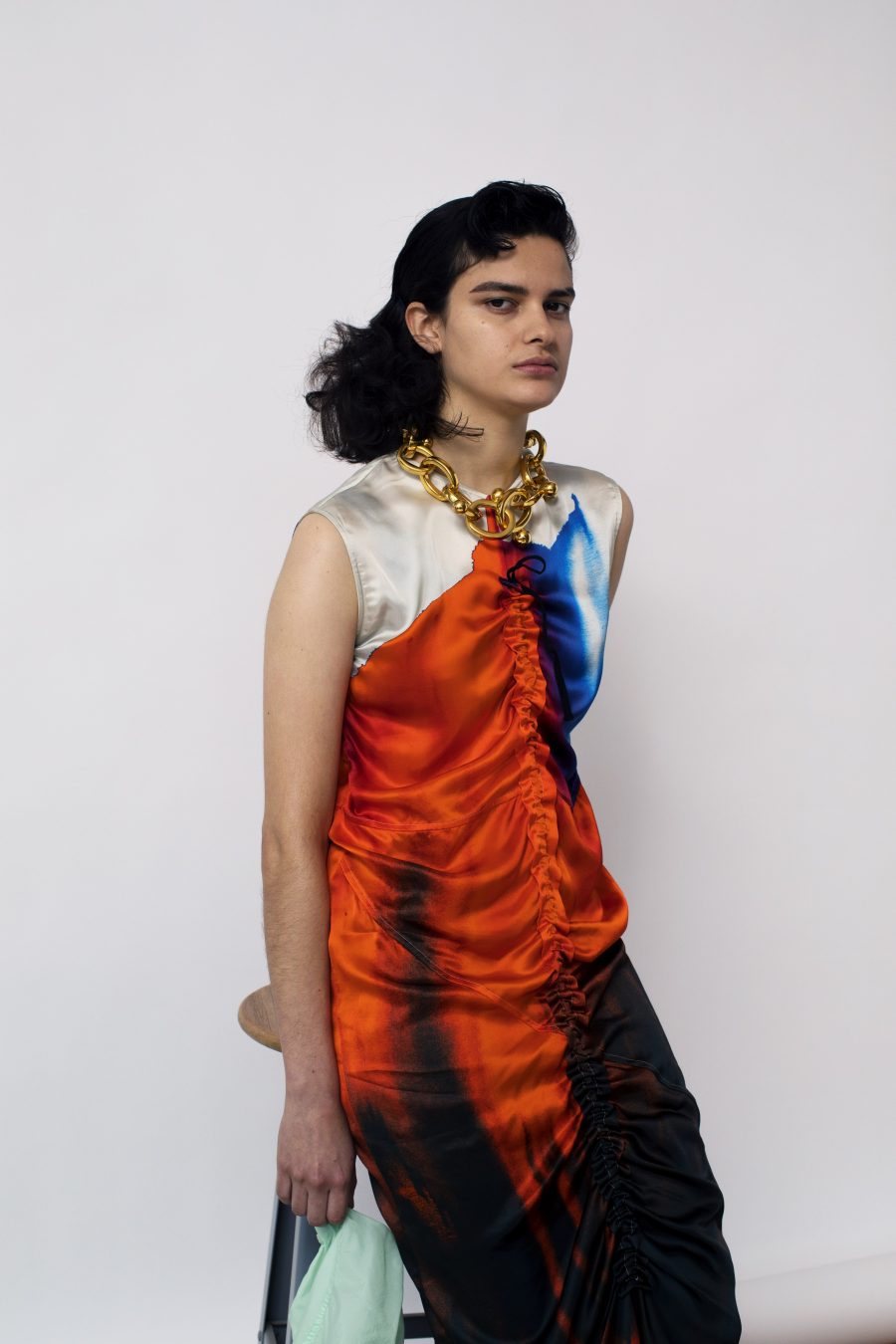
S: As well as upcycling you have hand painted elements and you use a lot of artisanal craft within the collection. How do you bring these elements together within the brand?
L: We’ve always really enjoyed craft and it’s actually a blessing that we’re small as it means we can do these amazing projects with people that we find on our journey. Molly met a woman selling bags on a beach in Mexico, made by the women of the Wayuu tribe in Columbia. So we worked with her to make some for us and now that’s part of the Colville journey.
And we’ve started doing rugs, Molly, tell us about your rug! Oh my gosh, a new one just arrived. It’s insane. It’s so fantastic.
M: At the beginning we were upcycling rugs and then actually a friend of mine Michelle is Turkish and she said you know if you ever want to make those rugs for Colville then I know artisans in Turkey that need work and so she started this project for us. We made these amazing striped rugs for the last lookbook which will be sold in September on the website. It’s incredible, one of the artisans is a school teacher who makes them with her friends in the evening and they sent us some photographs of them all sitting around the loom making these amazing carpets. We wrote to her and said, thank you so much! Michelle said, ‘I just want to keep these crafts alive in my country because they’re dying out’. Unfortunately it’s happening everywhere. We have just started working with my friend of mine in Mexico and he said, if you’ve got anything you want to do in Mexico let me know. He told me that the problem is these people are really suffering. Their livelihood is making things for the tourists but the tourists have stopped coming. So if we can make things there then we really want to make it work.
L: But it goes back to the fact that we want things to feel crafted and precious and unique. We’ve got so many pictures of all these women doing all these different things all around the world for Colville, it’s amazing. We have started working with a woman who works with 18 villages in Bangladesh making rugs and baskets. We had some of them in a pop up shop in Liberty just before lockdown. They are in our colours and patterns but still very much what they do, and I think that it is really important that we collaborate in that way. We don’t go in and impose what we want, it’s more that we see what they do and that it really fits into the collection really, really well.
M: When we first worked with the Columbian women we asked them to do a particular design but when the bags came back they were not at all what we had asked for and they really didn’t work for us at all. So we went back to the woman that I’d met on the beach in Mexico, who was our go-between between the tribe and us, and she said, well, the problem is, if they’re not happy, they don’t really want to work. They only feel they want to produce the bags if they’re really happy and if they’re happy with the design. So in the end we worked out that the best thing to do was that they would do the design specific to their tribe, and then they would just change the colours to what we wanted. We got there in the end and it feels really good to be working in this way.
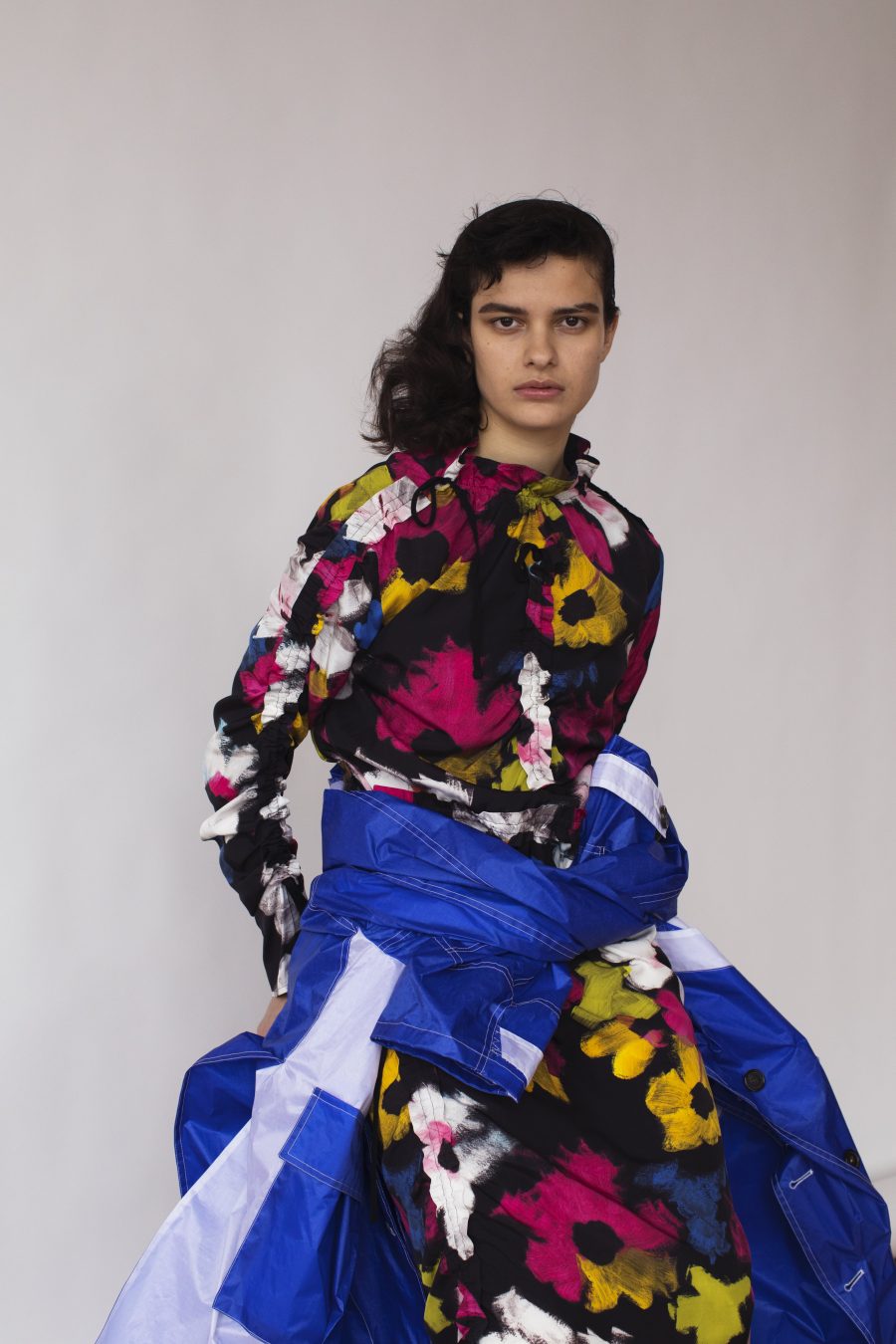
S: I think that’s a really lovely way to respond to people, that we are all people and that we have these different needs and wants in order to be able to create things and actually, it’s not just a tap that you can turn on. You need empathy and understanding about the women and how they produce.
L: And it’s slow, you know, we can’t just have it at the click of a finger. At Marni we used to see things the next day, and if you didn’t see them the next day then people lost interest. Everything has to be fast. The speed and the turnaround, the amount of product that we produced was just beyond! So it’s nice this slow cooking, you know, maybe we have to wait for a rug and we have to wait for the bag and we have to wait, and that’s okay, we will wait.
S: It’s lovely as well to see the Colville world extending beyond just the fashion wardrobe and thinking about how, with the rugs, you are starting to occupy space as well as
L: Yeah, I think Molly and I both – I can’t really understand how you wouldn’t want to (do interiors)!
Design is decoration. You want to decorate your body as much as you want to decorate the house that you live in and we just don’t draw a line between the two. I mean, why would you draw the line? I don’t understand that.
M: I think it also just came naturally. For a year and a half Colville was based in Kristin’s flat and when we finally got an office I just couldn’t think of what furniture that we could go and buy. So we just did everything ourselves. We made the desks. The only thing we didn’t do was the lights! We wanted it to be like a whole world you know, and it reflects who we are. We both really love interiors so it’s just like an extension. It just feels really normal.
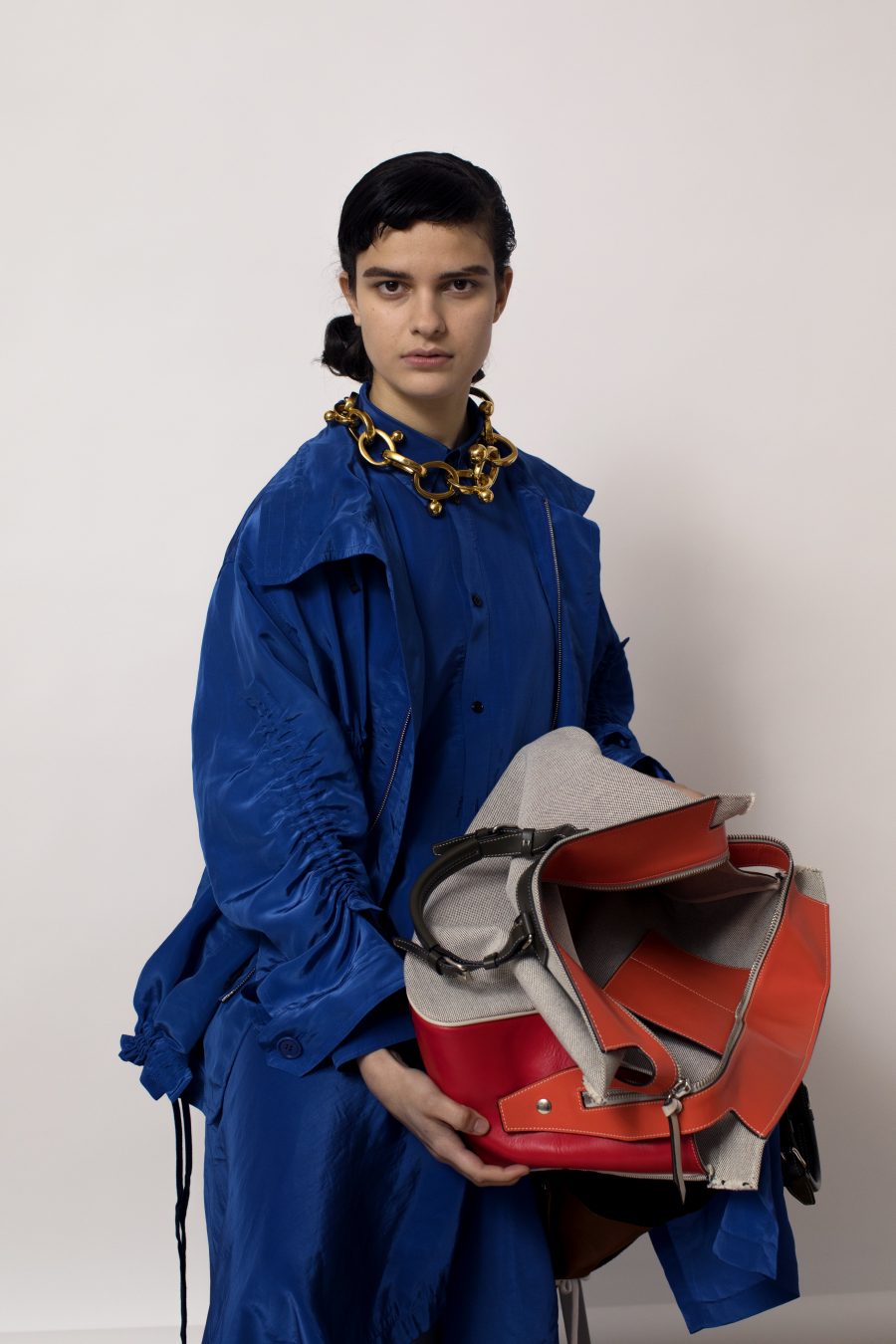
K: As a team you were already spread out between Milan, London and (your assistant Danny) in the Netherlands, so this new normal of working remotely is something you have been doing for a while. But how has the pandemic lockdown affected how you are able to collaborate?
L: We are good at communicating but I miss being in the office and touching everything, it’s exciting to be tactile you know, and not having that is hard. But so far it’s okay.
M: Yes fortunately I managed to come to London literally the week before the lockdown and I came with all the fabrics. So Lucinda saw the fabrics and we went through all the designs together then thank God. So since then I’ve been sending her things. I mean we work like that anyway, but you would have been to Milan twice now probably or I would have been to London with the jewellery. It’s going to be interesting when it comes to the fitting because that’s going to be odd. For Lucinda to not be able to touch and feel the clothes, because so much happens when we’re together in that room. Maybe we can travel to London but if we have to go into the quarantine then it’s going to be a long fitting!
K: So has the pandemic physically halted production?
M: Yes it stopped everything. All of our factories closed and they furloughed and they are not 100% up and running yet. Economically it’s a disaster. And we’re lucky because we’re small. It must be really frightening if you have even 50 employees. I consult for another company, and they are at 55 employees, and they’re pushing their collection to come out in July. And it just feels really weird. And we were lucky enough to say we’re going to wait till September because I don’t think people are going to feel ready to come out of a lockdown and think about buying big quantities and then having to do budgets and everything. So we decided to wait until September so we’re not so pressured at this moment, which is nice.

S: How are you guys spending your time in lockdown when you’re not working in Colville and when you’re not chained to your screens?
L: Well, I am very lucky to have a garden. So lots of gardening and I feel very privileged to have a garden. Because I can’t imagine what it’s like to be somewhere where you can’t get out. I sorted out all my fabrics and that was very therapeutic actually. But mostly snipping and snipping and pruning and deadheading.
But Molly has got really creative!
M: Yes I have! I was knitting at the beginning for our knitting initiative. We asked people on Instagram to send us knitted squares that we will make into a quilt and auction, with proceeds going to Cadmi a women’s refuge in Milan. We had such a good response. A friend of mine, her mum and her auntie knitted 40 squares. It’s been incredible. We have squares from Australia, Japan, somebody knitted something in metal that came from New York. So that’s been keeping me busy and been really enjoyable. I love it. And it’s been great to have the time to reply to everybody and say thankyou. But people have actually thanked us too and I understand that now. I knitted when I was a kid but not recently so I had to teach myself again by watching YouTube videos and it’s unbelievable how meditative it is. I find it really hard to meditate, my brain is just too whirry. But knitting really makes you focus and empties your head and I really got into it and I now understand why people get addicted to knitting because it’s very methodic.
L: It’s going to be really amazing putting them altogether. I am so excited. All those colors and patterns together. It’s gonna be amazing, amazing.
M: And we have a woman in the north of Italy, who owns the knitwear factory we work with. And she was really sweet. She’s made all different crochet ones and she called and I didn’t want to say to her, can you find somebody to help us put it together because it’s going to be a lot of crochet knit together. And she offered to find somebody to help with that. I love that everybody came together to make it happen. An old school friend’s mum got in touch and said she was knitting away, it’s been so great, it’s been really humbling and just really nice.

www.colvilleofficial.com


